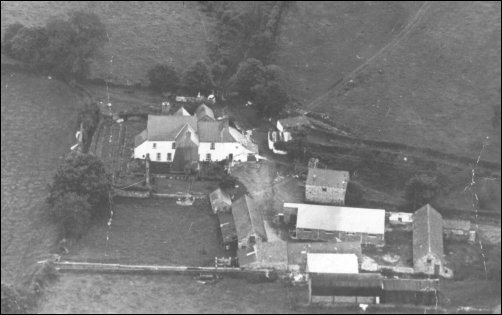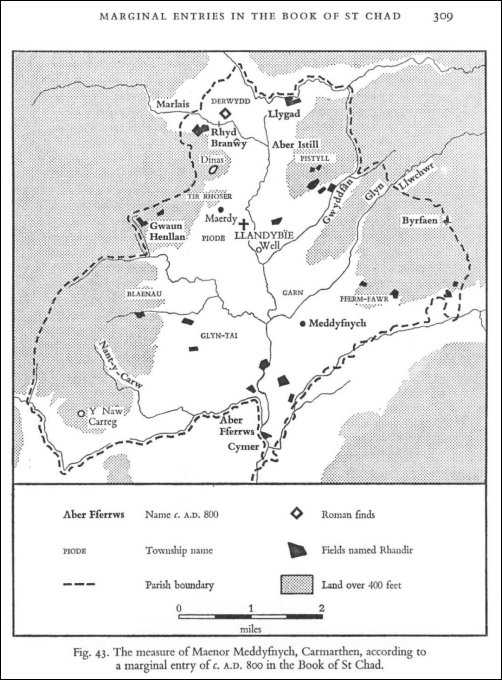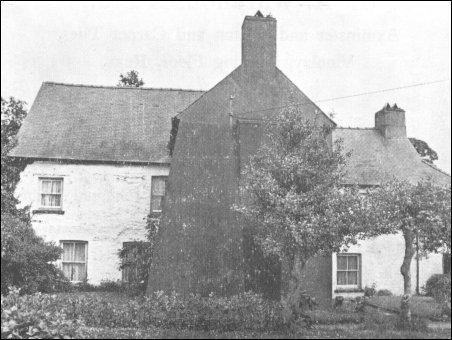To those of us brought up on Myddynfych council estate (built 1949–1951), the farm situated on the corner of the estate looks quite ordinary to the casual eye. Nothing special about it, or so it would seem: just a large farmhouse surrounded by the usual agricultural buildings like barns, haysheds, cowsheds, outhouses and the like. Many of us can even remember helping with the haymaking in the school summer holidays. Sandwiches and pop were our only reward but we felt like real men as we tossed the bales of hay around like feather pillows. Well, that's how it seems like now anyway.
But looks can be deceiving, and Myddynfych Farm's position on a modern housing estate disguises very ancient origins that go far back into the Welsh Dark Ages, that mysterious period in British history after the Romans left but long before the English arrived. For Myddynfych farm is the oldest inhabited building in Ammanford. Some reference books claim it can be dated to 800 AD or before, being mentioned in an early Welsh medieval volume, the St Teilo Gospel. The book is known in England, however, as the Book of Chad, or the Lichfield Gospels, as it is currently housed in St Chad's Cathedral, Lichfield, in Staffordshire (where the Bishops of Lichfield still use this manuscript to swear allegiance to the Crown). The book was originally known as the St Teilo Gospel as it was once housed in St Teilo Abbey, Llandeilo, around 800 AD. How this Welsh book, regarded as the finest book to have come from medieval Wales, came to reside in an English cathedral is a story in itself.
The Book was held in Llandaff monastery around 900 AD, at a time when the Diocese of Llandaff owned the medieval commote of Is Cennen, the land between the Towy and Amman rivers (a commote was a subdivision of a county in medieval times). By 1000 AD it had somehow found its way to Lichfield. The Book of Chad contains the Gospels, hand written in Latin, but in the margins of some of the pages there are notes written in a hand identified by paleographers (experts in ancient hand writing) to the 9th century, where the date 800 AD comes from. These notes also prove that it was in the possession of St Teilo Abbey, Llandeilo around 800 AD. It is not know for certain, however, where the book was actually written.
It is claimed that Myddynfych is mentioned in one of these marginal notes on the evidence of the following entry (written in Latin):
Ostendit ista consripsio nobilatatum mainaur med diminih et mensuram ...
Gomer Roberts in his Hanes Plwyf Llandybie, History of Llandybie Parish (p10 in the Ivor Griffiths translation), translates this thus:
This writing shows the nobility of Meddynfych Manor and its measure [ie boundaries] ...
The Latin word 'mainaur' means manor, and the word 'Meddynfych' can be inferred from the two Latin words 'med' and 'diminih', separate words in the marginalia, but when put together produce 'meddiminih', and Gomer Roberts in his book concludes:
"There is no doubt that the manuscript refers to Meddynfych Manor, and the boundaries match fairly closely to the present day boundaries of the parish of Llandybie".
Some of the names mentioned in the Book of St Teilo are completely unknown now but other names are still to be found on the parish boundary as it is today, such as the rivers Gwyddfan, Fferws, Nant y Carw, Nant Istill, Llwchwr, Marlais, Byrfaen and Gwaun Henllan.
More recent historians also believe that this Latin reference is indeed to Meddynfych and some claims for the its age go back as far as the 6th century. Wendy Davies in her book 'Wales in the Early Middle Ages' is one who believes that it is indeed Myddynfych which is mentioned:
"The maenor of Myddynfych (which includes modern Llandybie) is mentioned in the sixth of the Lichfield marginalia, in the ninth century; its perambulations indicate that its extent was only slighlty less than that of the modern parish of Llandybie ... and its reference to 'Gwaun Henllan', (the meadow of the old church), suggests a religious settlement within its bounds (see map above)." [This would have been the original wood-built Celtic church, not the later stone-built Norman structure that currently graces the village of Llandybie]. (Wendy Davies, 'Wales in the Early Middle Ages' (Leicester University Press 1982, page 44).
What is certain however is that Myddynfych is mentioned in a 14th century poem by Llewelyn Goch (Amheurig Hen) who was born in Ynystawe in the Swansea valley. The bard wrote of a journey he made through the region of the Towy passing through Myddynfych. Llywelyn Goch ap Meurig Hen ( fl 1350 -1390) is thought to have belonged to the Nannau family of Llanfachreth, Merionethshire, and only twelve of his poems have survived in 'Llyfr Coch Hergest' [The Red Book of Hergest] now kept at the library of Jesus College, Oxford. The following lines occur in 'Moliant Hopcyn ap Tomas, Ynysforgan' [Praise of Hopcyn son of Thomas, Ynysforgan], a nobleman and patron of poets from the Swansea Valley. Hopcyn ap Tomas (fl. 1330 -1408) is thought to have commissioned 'Llyfr Coch Hergest'. This particular awdl (ode) was probably composed between 1370 and 1390. The poet describes his journey from north Wales to Ynysforgan, the home of his patron:
Hwyliaf, addefaf, o Ddyfi – ardal
Trwy ochel Pennal, tryfal trefi,
Dieres goethynt dros Gothi, – Dulas
I Feddyfnych blas heb fodd ofni,
Trwy Lychwr at ^wr ni ad torri – ffydd ...Professor Dafydd Johnston (Dept of Welsh, Swansea University) has translated the ode into modern Welsh in 'Gwaith Llywelyn Goch ap Meurig Hen' which was published by the Centre for a Advanced Welsh and Celtic Studies at the National Library of Wales, Aberystwyth, in 1988. The lines above now read as follows:
Teithiaf, cyffesaf, o ardal Dyfi
Gan osgoi Pennal, triongl o drefi,
Hynt wych arferol dros Cothi, Dulas
I lys Meddyfnych heb unrhyw ofn,
Trwy Llychwr at ^wr na fydd yn caniatau torri addewid ...In an English translation made for this web site:
I travel, I confess, from the area of Dyfi,
Avoiding Pennal, triangle of towns,
The fine, customary way over Cothi, Dulas
To Myddynfych manor with no fear,
Through Loughor to a man who will not permit the breaking of a promise ...[Note: Dyfi, Cothi, Dulas and Loughor are local rivers.]
The current farmhouse that stands on the north-east corner of Myddynfych housing estate (see photograph above), while not the original medieval building, is still ancient enough, and is substantially the same structure that was built in the 16th–17th centuries; that is, at the time of Shakespeare (see he CADW survey of the building below). It is doubtful, though, if any of the estate's children who studied Shakespeare at school were ever aware of this, or that it would have made their studies any more tolerable if they had been.
Origin of the name 'Myddynfych'
Gomer Roberts, in attempting to explain the word 'Meddynfych' in Hanes Plwyf Llandybie, comments:
"Professor Ifor Williams believes that a personal name is the basis of the word Meddynfych. He states that they changed 'medd diminih' of the 10th century to Meddynfych before 1400 ... We can analyze Meddynfych to 'Ma', a level place, and 'Dyfnych' (with a grammatical change of the 'ma' to 'me' before the 'y'."
(Sir Ifor Williams was for many years Professor of Welsh at Bangor University and was the foremost Celticist of his day. Place-names were his forté).
That would appear to be that, but we cannot leave matters there as the word gives rise to an amusing variety of suggested etymologies. W T H Locksmith in his book of Ammanford street names gives two different derivations in as many paragraphs in his entry for Myddynfych:
"It is believed that at one time a small fort, or camp, standing on raised ground near the river Loughor, existed close to the present site of the farm – called a 'Byddinfach' (translated meaning a 'small army'.")
This is possible, as 'Byddin' is modern Welsh for an army and 'bach', or 'fach' means small. The very next paragraph, however, states that it derives from:
"'midd' meaning an enclosed place', 'yn' is a diminutive to show smallness and 'bych' or 'fych' is cattle – 'the smallest enclosed place for cattle.'"
It's also been conjectured that the 'myddyn' part of the word is a corruption of 'mynydd', or mountain, the name then meaning 'small mountain'. Again this is at least plausible, as the farm stands at the foot of a small hill leading up to the Gorsedd and on which All Saints Church also stands.
We'll give the final word to Gomer Roberts, who wisely leaves the matter alone: "On that we shall leave the philologists and their conjectures."
In the late 1890s the farm and its land were bought up by Mr Henry Herbert of Brynmarlais, Bonllwyn. In 1949 The field adjoining Llandybie Road at Tirydail Square was bought by the local council, and the modern housing estate of Myddynfych was built. The farm however, appears to be steadily deteriorating under its current tenancy. Myddynfych farm is still occupied to this day, though in a much sorrier condition than even twenty years ago. Even though it is now a listed building there is concern that such a historic farmhouse may not survive its recent years of neglect for much longer. In an age when most buildings are lucky enough to see 100 years, so keen are the property developers and their bulldozers to get to work, it would be a shame to see anything happen to a such a venerable survivor as Myddynfych farm.
Whatever the age of Myddynfych farm, it is ancient indeed and is one of the few tangible remnants of the medieval political and administrative structures in our area. We take local government for granted today as being fairly recent creations; yet surprisingly, many of today's parish boundaries are not that different from those of the 13th and 14th centuries. The modern Llandybie Community Council, if added to today's Ammanford Town Council and Cwmamman Community Council, gives a pretty close fit to the ancient parish of Llandybie in the Commote of Iskennen. Iskennen, also spelled Is Cennen, was the area between the Towy and Amman rivers, whose administrative—and military—centre was mighty Carreg Cennen castle, perched threateningly on a limestone outcrop 300 feet above the river Cennen. Here is the way the locality was organised in the Middle Ages (of course, Ammanford did not exist at all, being just the southernmost corner of the Commote – or Cymwd – of Iskennen).
Cymwd Iskennen
"Cymwd" = Commote; "Is" = lower; therefore "The Commote below the river Cennen", (ie south of Llandeilo). Commote is generally used for Cymwd in English books. A Cymwd/Commote is a sub-division of land in a larger Cantref. A Cantref was the Welsh equivalent of the Anglo-Saxon Hundred, both being administrative units made up of approximately a hundred townships.
Each Cantref was sub-divided into two Cwmwds/Commotes so there were 50 trefydd (townships) in each Cymwd/Commote. A cantref is approximately equivalent to a modern borough ('cant' = a hundred and 'tref' = town). There were therefore one hundred trefydd in the Cantref. The Cymwd was further divided into twelve maenolydd (manors) of four trefydd each, making 48 trefydd in all and with the two extra trefydd or towns being the property of the king. "In addition he [ie the King] received an annual food-rent (gwestfa) from each free maenol (eight per commote) and a summer and winter food-gift (dawnbwyd) from each non-free maenol, as well as some more or less onerous services such as building works, carting and hospitality." (Wendy Davies, 'Wales in the Early Middle Ages' (Leicester University Press 1982, page 43). Clearly, being a King had much going for it.
The modern Welsh word 'tref' is usually translated as 'township' but towns in the Middle Ages were far smaller affairs than their modern counterparts, and were basically small settlements of a few homesteads and farms, equivalent to todays villages.
The Amman Valley is situated in Cwmwd Iskennen of the Cantref Bychan. Had there been postal addresses in those days Ammanford might possibly have read something like this: Manor of Myddynfych (Parish of Llandybie), Commote of Iscennen, Cantref Bychan (Borough of Dinefwr), Dyffryn Tywi (Carmarthenshire), Kingdom of Deheubarth (Dyfed).
Myddynfych Farm was the centre of the local administrative structure of the Middle Ages, with the Lord of the Manor who lived there having extensive powers over the people within his manor. And in the days of serfdom, he would have literally owned the people living within his territory as well as the land they worked. As their lord and owner he would have acted as the local police force, prosecutor, magistrate and jury in matters of law. And if that wasn't enough, tax collector and recruiting officer in times of war were also in his job description.
Perhaps the age of Myddynfych Farm should be left to the Welsh ancient monument organization CADW who surveyed the building in 1994. (Cadw is the Welsh for 'to keep').
Sources:
Hanes Plwyf Llandybie (History of the Parish of Llandybie). Originally published in Welsh by Gomer Roberts in 1939 and translated into English by Ivor Griffiths. Published privately 2000.AMMANFORD: Origin of Street Names & Notable Historical Records by W T H Locksmith. Published in 2001 by Carmarthenshire County Council.
--------------------------------------------------------------------
CADW report 1994. Their report contains highly technical architectural language but is worth reprinting nonetheless:
CADW Survey
Authority Carmarthenshire . Grade II . Date Listed 10/08/1994
Community Ammanford . Grid Ref SN 6293 1324 . Record No 14811Name MYDDYNFYCH, MYDDYNFYCH (NE SIDE)
Exterior: Situated beyond NE corner of Myddynfych housing estate.
History: The house is mentioned in a poem of the late C14 and the descendants of Gruffydd ap Sir Elidir were here from c1400 to the C17. Walter Lloyd, gent. was owner in the later C17, before it passed in the early C18 to John Jones (d1756), son of J Jones of Coalbrook, Pontyberem. After 1756 the house was tenanted as the family moved to Dyffryn, nearby.
Exterior: C16 to C18 gentry house, now farmhouse. Colourwashed render and slate roofs, cross plan, with rendered stacks on S end and W end gable and massive lateral stack in NE angle. Two storeys and attic. Tallest part, the N range is probable oldest, C16 raised in C17, with lateral stack to E, the chimney breast exposed stone, stepped in and rendered above. Four-pane sash each floor to right. N end gable has lean-to and W side has window each floor. E and W wings are in T-plan to main range. Short E wing contains staircase and is stone, rendered in gable with two windows. W wing has rendered W stack, colourwashed S wall with four-pane sash to first floor centre and ground floor right, 6-panel main door set diagonally in angle to S wing. S wing has lowest eaves, 4-pane sash to first floor centre and ground floor left of centre. Big lean-to on S end with long roof hipped at join with main roof. One door and small upper window.
Interior: Not inspected. In 1991 there were plastered chamfered beams in the N room, the main fireplace was narrowed with the lintel cut. The first floor had evidence of an earlier gable level, suggesting a C16 open hall raised later in C17. 4-bay collar truss roof, probably late C17. The E gable had a stone stair winding about a solid stone core, relating to the present floor levels, so probably C17. W range had chamfered beam to ground floor, thick E wall to main house, and a single bent-footed truss. It could be a C16 parlour wing and there may have been a mural stair between the two ranges. S range is later C17 or C18, and had ogee-stopped chamfered beams and two W side cupboard recesses. Roof trusses were chamfered collar trusses.
A good example of a multi-period vernacular gentry house, a type scarce in this locality.
Reference: Francis Jones Historic Carmarthenshire Houses 1987, 135-6
Royal Commission on Ancient and Historic Monuments report.



